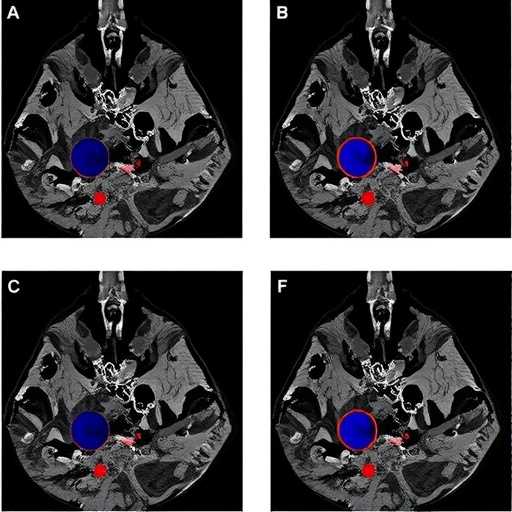In a groundbreaking new study published in BMC Cancer, researchers have shed light on the intricate relationship between tumor-draining lymph nodes (TDLNs) and the formation and maturation of tertiary lymphoid structures (TLSs) in patients with lung adenocarcinoma (LUAD). These ectopic lymphoid aggregates, composed predominantly of immune cells, have long been associated with favorable clinical outcomes and enhanced response rates to anti-tumor immunotherapies. However, the mechanisms driving their development and progression have remained elusive until now.
Lung adenocarcinoma, a leading cause of cancer-related mortality worldwide, often exhibits a complex tumor immune microenvironment where the interaction between tumor cells and immune cells can dictate disease progression and therapeutic response. The role of TLSs within this microenvironment has garnered significant attention due to their potential in orchestrating local immune responses and improving patient prognosis.
The study, conducted on tissue slides from 120 LUAD patients, employed advanced multiplex immunofluorescence (mIF) techniques to quantify and characterize TLSs and to analyze the immune landscape within tumors and TDLNs. Two distinct staining panels allowed for a comprehensive assessment: the first panel highlighted TLS components such as CD20+ B cells, CD21+ follicular dendritic cells, and CD23+ markers, while the second focused on the broader immune environment, including CD4+ and CD8+ T cells alongside CD20+ B cells.
Remarkably, patients with detectable TLSs exhibited significantly better disease-free survival (DFS) and overall survival (OS) compared to those without TLSs. Median DFS in TLS-positive patients was approximately 71 months, contrasting starkly with 29 months in TLS-negative individuals. Similarly, median OS for TLS-positive groups reached over 77 months, whereas it was not reached for TLS-negative counterparts within the study timeframe, underscoring the prognostic significance of TLS presence.
Delving into the cellular contributors to TLS development, the research identified B cells within both the tumor microenvironment and TDLNs as pivotal players. A higher ratio of tumor-infiltrating B cells to those within TDLNs correlated positively with the abundance of TLSs, suggesting a dynamic migration or expansion mechanism that fosters TLS assembly in tumor tissues.
Beyond mere presence, the functional state of these B cells emerged as crucial. Among the subsets identified, TIM-1-positive B cells in the TDLNs demonstrated a compelling association with impaired TLS maturation. This unique immunosuppressive B cell population seemed to hinder the progression from immature to fully mature TLSs, which are essential for robust anti-tumor immune activity. The inverse correlation between TIM-1+ B cell prevalence and mature TLS percentage highlights a novel immunoregulatory checkpoint that might be exploited therapeutically.
The implications of these findings extend beyond mere biological insight. Targeting TIM-1+ B cells in TDLNs could represent a strategic conduit to enhance TLS maturation, thereby bolstering local anti-tumor immunity and improving clinical outcomes for LUAD patients. This concept aligns with emerging immunotherapeutic paradigms aimed at modulating the tumor immune microenvironment to overcome resistance and enhance efficacy.
Moreover, this research underscores the importance of the lymph node-tumor axis in cancer immunology. While much attention has focused on primary tumors and circulating immune components, the sentinel lymph nodes, particularly those draining the tumor site, appear to function as critical immunological hubs influencing local and systemic responses. Understanding the cellular and molecular crosstalk within these nodes offers new avenues for diagnostic and therapeutic innovations.
The study’s methodological strength lies in its utilization of multiplex immunofluorescence, enabling simultaneous visualization and quantification of multiple immune markers within spatial context. This technique provides a robust platform to dissect complex cellular interactions and heterogeneity that conventional methods might overlook, enriching our understanding of tumor immunobiology.
Clinically, the presence of TLSs detected through non-invasive or minimally invasive biopsy sampling could emerge as a valuable prognostic biomarker, guiding treatment stratification and personalized immunotherapy approaches. Furthermore, monitoring TIM-1+ B cell populations in TDLNs might help predict TLS maturation status and therapeutic responsiveness.
Future research stemming from these findings will likely explore mechanistic pathways by which TIM-1+ B cells suppress TLS maturation, including potential signaling cascades and cellular interactions involved. Additionally, translational studies assessing the efficacy of TIM-1 blockade or depletion strategies in preclinical models could pave the way for novel combinational immunotherapies.
In summary, this pioneering work reveals a sophisticated immunoregulatory network centered on tumor-draining lymph nodes and B cell subsets that govern the formation and maturation of tertiary lymphoid structures in lung adenocarcinoma. By illuminating the dualistic roles of B cells — both supportive in TLS formation and inhibitory via the TIM-1+ subset — the study opens promising therapeutic avenues aimed at harnessing the immune system more effectively against one of the deadliest malignancies.
This paradigm shift promises to refine our approach to lung cancer treatment by targeting not just the tumor but the immune ecosystem integral to cancer progression and control. By enhancing TLS maturity and function, clinicians may soon offer patients improved prognoses and more durable responses to immunotherapy, marking an exciting leap toward precision oncology.
Subject of Research: Lung adenocarcinoma, tertiary lymphoid structures, tumor-draining lymph nodes, B cells, tumor immune microenvironment, immunotherapy
Article Title: Effect of tumor draining lymph nodes in the formation and maturation of tertiary lymphoid structure in patients with lung adenocarcinoma
Article References: Wen, J., Yun, W., Yin, X. et al. Effect of tumor draining lymph nodes in the formation and maturation of tertiary lymphoid structure in patients with lung adenocarcinoma. BMC Cancer 25, 1507 (2025). https://doi.org/10.1186/s12885-025-14913-3
Image Credits: Scienmag.com
DOI: https://doi.org/10.1186/s12885-025-14913-3





